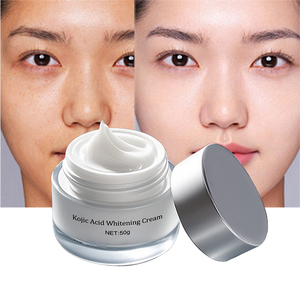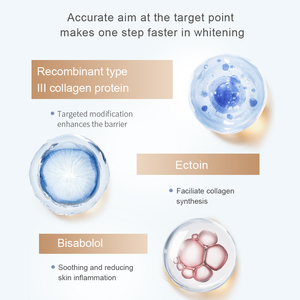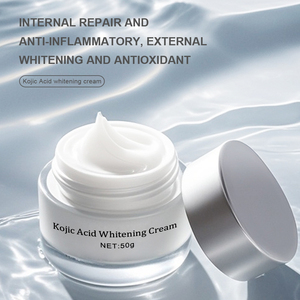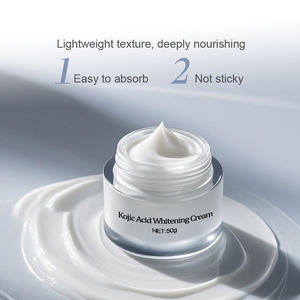
All categories
Featured selections
Trade Assurance
Buyer Central
Help Center
Get the app
Become a supplier

(908 products available)


















































Market Size: The global market for melanin reducing creams is part of the broader facial skincare segment, which is projected to reach $142.11 billion by 2030 with a compound annual growth rate (CAGR) of 5.8% from 2023 to 2030. This growth is driven by increasing consumer awareness about skincare and rising disposable incomes in emerging markets such as China and India. The demand for skin-whitening agents, particularly in Asia-Pacific, has significantly contributed to this trend, further solidifying the market for melanin reducing creams.
Consumer Insights: The primary consumers of melanin reducing creams are women, who accounted for over 58.76% of the overall facial care revenue in 2022. Key purchasing drivers include product efficacy, ingredient transparency, and the presence of certifications that assure safety and effectiveness. Consumers are increasingly seeking products with natural ingredients, as evidenced by a 32% increase in sales of COSMOS-certified products in 2021. There is also a notable demand for personalized skincare solutions that cater to individual skin concerns.
Top Brands Dynamics and Innovators: Major brands are focusing on innovative formulations that include skin-brightening ingredients like Vitamin C and niacinamide. For instance, recent product launches from leading companies have emphasized the inclusion of natural and organic components to meet the growing consumer preference for clean beauty. Moreover, the rise of e-commerce has enabled brands to reach a wider audience, making melanin reducing creams more accessible to consumers globally.
Melanin reducing creams are specially designed to suppress melanin production. Melanin is the pigment that gives skin its color. When it is produced in excess, it causes dark patches. Melanin reducing creams come in different types, which include;
Vitamin C Creams
These are creams rich in vitamin C. The vitamin is known to inhibit tyrosinase, the enzyme responsible for melanin production. Apart from preventing melanin from forming, vitamin C also helps lighten dark spots. It works well with other ingredients like vitamin E and ferulic acid. That makes the cream very effective in brightening the skin tone. However, when using vitamin C creams, one should always wear sunscreen. The creams can make the skin sensitive to sunlight.
Niacinamide Creams
Niacinamide is a vitamin B3 derivative. It works by inhibiting the transfer of melanin from melanocytes to keratinocytes. In addition, it helps brighten skin, reduce fine lines, and treat hyperpigmentation. Niacinamide creams are effective in brightening skin tone. It is because they reduce the amount of melanin that reaches the skin surface. Users can apply niacinamide cream on all skin types.
Alpha Arbutin Creams
Alpha arbutin is a powerful antioxidant that prevents melanin production. It is derived from hydroquinone and is present in various skin-lightening creams. Arbutin also protects the skin from UV rays. Alpha arbutin cream is most effective when applied on clean skin. This ensures it is absorbed well and does not mix with other ingredients.
Glycolic Acid Creams
Glycolic acid is an AHA that inhibits melanin production. It exfoliates the top layer of the skin, where most of the dark spots are. Glycolic acid creams also improve skin texture and tone. However, users should be careful when using glycolic acid. It can cause irritation, especially when starting. It is best to use it at night and gradually increase the frequency.
Retinol Creams
Retinol is a vitamin A derivative that helps brighten the skin. It works well in reducing melanin production. Retinol creams are also effective in reducing fine lines and wrinkles. People with sensitive skin may experience skin irritation when using retinol cream. It can cause rashes, redness, and peeling. Users should start with a low concentration and use it at night.
Kojic Acid Creams
Kojic acid is another tyrosinase inhibitor like glycolic acid. It also works well in reducing melanin and dark spots. Moreover, kojic acid creams have antioxidant and antibacterial properties. They help protect the skin from free radicals and bacteria. However, kojic acid can be harsh for some people. It is best to use it in low concentrations.
Wholesale buyers should consider the following factors when choosing melanin-reducing creams to stock for retail or business use.
Skin Type
Every skin type has its unique requirements. Therefore, it is important to select melanin cream for face products tailored to the needs of specific skin types. For instance, people with oily skin should consider melanin-reducing creams that are oil-free and non-comedogenic so that they do not block pores. On the other hand, individuals with dry skin should opt for products containing moisturizers to avoid any dryness or irritation.
Ingredients
The effectiveness and safety of melanin-reducing creams depend on the ingredients. So, buyers should choose products with clinically proven ingredients like hydroquinone, kojic acid, arbutin, or niacinamide. These ingredients help reduce melanin production in the skin. It is also advisable to avoid products with potentially irritating chemicals, such as synthetic fragrances or harsh detergents.
SPF Protection
Some melanin-reducing creams contain sunscreens that offer SPF protection. Buyers should choose these products since they provide dual benefits. The cream reduces melanin production in the skin, while the sunscreen protects it from harmful UV rays. This helps prevent dark spots from resurfacing due to sun exposure.
Brand Reputation and Reviews
Wholesale buyers should choose melanin-reducing creams from reputable brands. This is because such brands offer quality, safe, and effective products. In addition, the creams will have positive reviews from users, which help build trust and assure potential customers that the product works.
Allergies and Sensitivities
While melanin-reducing creams are generally safe, certain ingredients may cause allergic reactions or skin sensitivity in some people. Therefore, buyers should consider products with fewer allergens. They should also advise customers to perform a patch test before using any new skincare product to check for any signs of irritation.
Cost and Value
The price of melanin-reducing creams varies depending on the brand and quantity. Wholesale buyers should consider their budget and the value offered by different products. Choosing products that provide the best results at a reasonable cost is recommended.
It is vital to follow the instructions on the label or those given by a healthcare professional when using skin brightening creams. Some general instructions for using the cream include the following:
Thoroughly cleanse the skin
Before applying the cream, wash the face or any other part where the skin lightening cream will be applied. Use a gentle cleanser and warm water to remove dirt, sweat, and excess oil from the skin. Pat the skin dry using a clean, dry towel.
Apply the cream
Apply a thin layer of the melanin reducing cream to the affected areas. Check the product label to know the recommended frequency of application. Most manufacturers recommend applying the cream once or twice every 24 hours. Also, check if the cream is meant to be applied during the day or at night.
Use the right amount
The amount of cream to use depends on the formulation. For creams and ointments, users should apply a small amount that can cover the entire affected area. When using gels, users should apply a quantity that is equal to the size of a pea.
Wash the hands after use
Always wash the hands with soap and water after applying the cream. This prevents the accidental spreading of the cream to other body parts and the eyes.
Follow a skincare routine
When using melanin creams, buyers need to follow a simple skincare routine. This includes cleansing the skin and applying moisturizers to help the cream work better.
Using melanin reducing creams can be safe when users follow the tips mentioned above. However, it is vital to consider the following factors to ensure the safe application of the cream.
Consult with a healthcare professional
Before using a skin brightening cream, it is advisable to consult with a healthcare professional. They will recommend the best type of cream to use and the correct application methods. They will also advise users on the right formulation depending on their skin type.
Check the ingredients
Checking the ingredients list is important to ensure that the cream has safe and effective compounds. Avoid creams with harmful ingredients, like hydroquinone. This compound can damage the skin and cause severe rashes and redness.
Do a patch test
Before using the cream, do a patch test on a small section of the skin. Observe how the skin reacts after applying the cream. If the skin develops any adverse reaction, discontinue use and seek medical advice.
Follow the recommended usage
Always follow the recommended usage on the product label. Avoid using the cream for a prolonged duration as it may have adverse effects on the skin.
Melanin creams have functions and features that help people reduce melanin in their skin. Here are some of them:
Safe
Reducing melanin in the skin can be safe for many people. The FDA and other health agencies have approved various safe methods for reducing melanin. However, some methods may have mild side effects for some users. So, it is essential to consult with a qualified healthcare provider before using any new melanin-reducing products or treatments.
Organic
Many organic melanin-reducing creams are made from natural plant extracts. They do not contain any harsh chemicals or artificial additives. This makes the creams safe for use by people with sensitive skin. Organic creams also have other benefits for the skin, like improving its texture and keeping it hydrated.
Multiple use
Some cream for reducing melanin has ingredients that can provide other benefits to the skin. For example, a cream with vitamin C can reduce melanin and also act as an antioxidant. It will protect the skin from damage caused by free radicals. A cream with retinol can reduce melanin and also reduce the appearance of wrinkles.
Targeted treatment
Some melanin-reducing products are designed to treat specific areas of the skin. They help reduce melanin in these areas for people who want targeted treatment. Examples are spot treatments or creams that are applied to specific areas with dark spots or hyperpigmentation.
Non-invasive
Melanin-reducing creams provide a non-invasive option for individuals seeking to reduce melanin levels in their skin. Unlike surgical procedures, these creams offer a way to achieve desired results without the need for invasive treatments. They work by gently exfoliating the skin or inhibiting melanin production.
Customizable formulations
Some manufacturers offer different formulations of melanin-reducing creams. This allows healthcare providers or patients to choose the formulation that best meets the needs of the patients or individuals. The available formulations may vary in their active ingredients, consistency, or methods of application.
Q1: Will melanin-reducing cream lighten the skin?
A1: Yes, it reduces the amount of melanin in the skin. With reduced melanin, the skin becomes lighter.
Q2: Does skin lightening cream with hydroquinone contain a safe?
A2: Many melanin lightening creams contain hydroquinone. The creams are safe for short-term use. So, users are advisable to use them for only three to six months. To ensure long-term use, buyers should consider creams with kojic acid or arbutin. These options are safer for using them in the long term.
Q3: Do dermatologists recommend melanin reducing creams?
A3: Dermatologists recommend some skin lightening creams. They usually advise the use of alternatives like exfoliating agents, retinoids, or laser therapy. They will advise the use of these alternatives to address skin issues like hyperpigmentation. So, dermatists can endorse melanin-reducing creams, but they will likely recommend other options.
Q4: What are the side effects of melanin-reducing creams?
A4: The side effects of melanin-reducing creams include skin irritation. Others are increased sensitivity to the sun and uneven skin tone. Using creams with excess hydroquinone can cause more side effects. These side effects can include a rash, redness, and a burning sensation. In some cases, the skin can thicken, and it will turn black.
Q5: How does one identify an original melanin-reducing cream?
A5: The packaging of the cream will be of good quality. The cream will have a clear label with the active ingredients, method of use, and expiry date. The ingredients will be listed in English. An original melanin-reducing cream will have a hologram sticker. This sticker will show the product's batch number and barcode. When scanned, it will show whether the product is genuine or fake.